Coronavirus (COVID-19) volunteering - third sector perspectives: survey report
Findings from a survey undertaken to gather insights into the experiences of Scottish third sector organisations and other stakeholders involved in supporting volunteering during the pandemic.
7 Current situation and recovery
We asked the survey respondents to tell us their views about the current situation in relation to volunteering at the time of the survey, and to explore their expectations about how this might change during the remainder of 2021 and into the next phase of COVID recovery.
7.1 Perspectives on recovery in volunteering numbers
As shown in Figure 3.1 above, 58% of responding volunteer-involving organisations said that their volunteer numbers had decreased during the pandemic – with 30% saying that they had experienced a major decrease in volunteer numbers. This was primarily a result of two main factors: organisations having to pause their operational programmes because of COVID restrictions or lack of access to premises – with the result that they could no longer offer their usual number of roles for volunteers; and pre-existing volunteers having to withdraw from volunteering – especially those who were older or who had health conditions.
At the time of this survey (April-June 2021), many organisations were beginning to restart or increase volunteer work as COVID restrictions were being eased. It was not yet clear whether and when volunteers who had paused their volunteering due to COVID would choose to return to volunteering. We asked VIOs whether the current volunteer supply was meeting their needs.
7.1.1 VIO views on the current volunteer supply
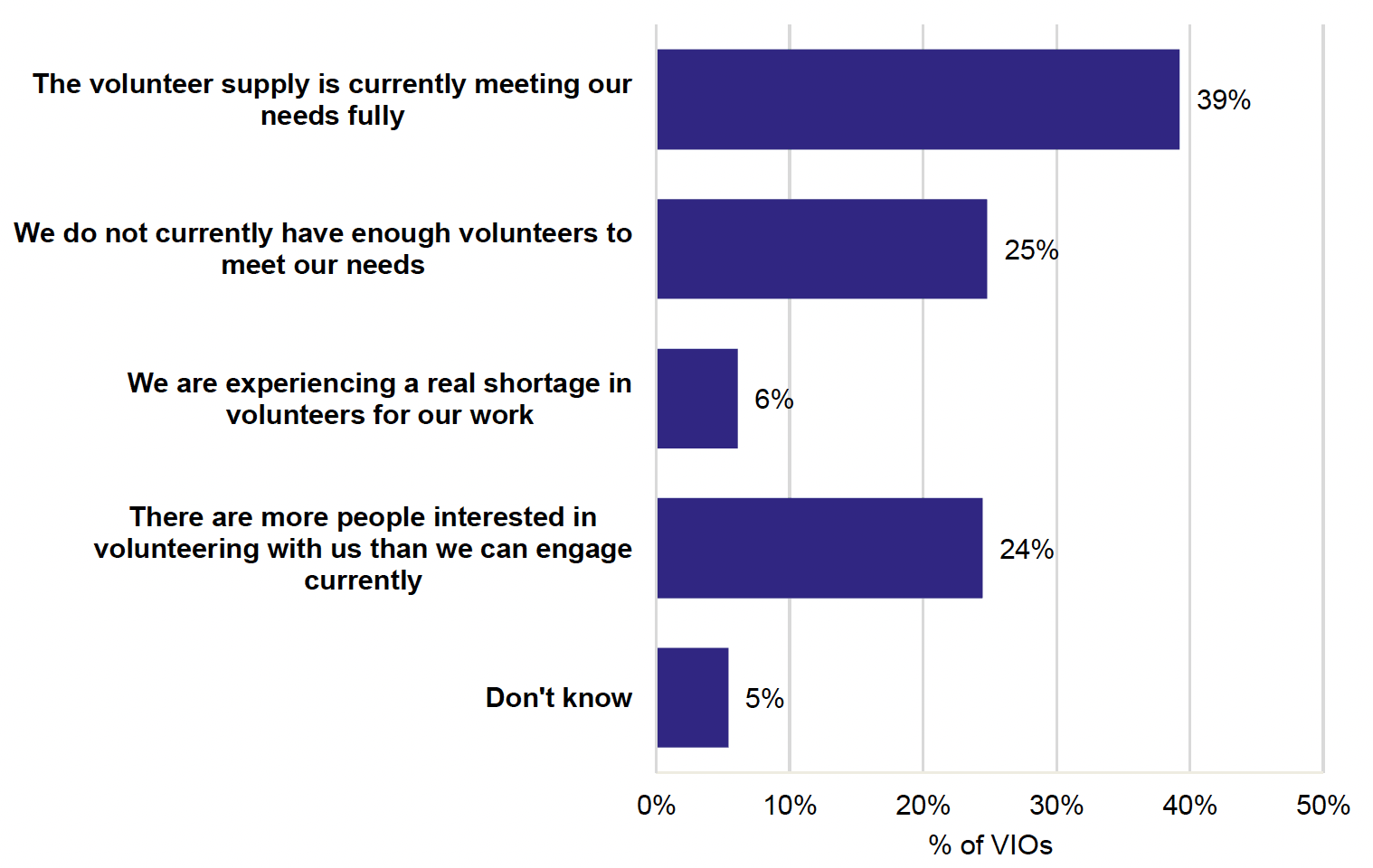
As Figure 7.1 shows, VIO views on the adequacy of the current volunteer supply varied considerably. Thirty-nine percent of VIOs said that the volunteer supply was meeting their current needs; 31% said that they did not have enough volunteers or were experiencing a real shortage; and 24% said that there were more people interested in volunteering with them than they could currently engage. The text responses also reflected this range of experience, and highlighted a dynamic situation as organisations were gradually restarting programmes and reopening their premises following the end of the second lockdown.
Organisations which were struggling with not having enough volunteers were often those that were in a period of restarting their volunteering programme after a break, and were finding that some of their pre-existing volunteers were not able or willing to return. There was a range of reasons for this, including continued apprehension amongst older volunteers in particular in relation to volunteer safety/COVID; loss of confidence amongst volunteers after having stopped for so long; and for some volunteers, a reassessment of priorities that mean they no longer had time to volunteer for the organisation.
'A number of our retail volunteers have decided not to return to volunteering due to the pandemic. A large number of these volunteers were of an older age and the past year has in a lot of ways diminished their confidence. Some may come back when they see things improving. This has left us with a great need for new volunteers in our 14 shops.
We have a lot of volunteers waiting to come back to roles within the hospice but due to some restrictions still in place and the changes in the way we offer services there may not be the same demand for these volunteers. I have been trying to steer some of these volunteers to our retail shops but given our geographical area that is not always possible as many of our shops are too far away from our main base.'
'People are wary of committing because of COVID anxieties. Some of our volunteers have caring responsibilities, so would not put their loved ones at risk. However we have recently advertised for more volunteers and people are beginning to come forward. It depends on the task though. Volunteers are happier about outdoor roles where distancing is easier.'
'There is continuing concern and apprehension about COVID-19 to put off our older volunteers and those with health issues.'
Meanwhile, the ending of furlough meant that some of the newer volunteers who had started volunteering during the pandemic no longer had time for volunteering during the day.
'Many of the volunteers that have come forward as a result of the pandemic are working age who were furloughed, for the community transport we require volunteers that are free during the day'
Some organisations said that they were struggling to find volunteers with specific skills or who are willing to take on particular roles in the organisation, with some roles being easier to attract volunteers to help with than others.
'We have found it difficult to match volunteers to roles. People came forward to volunteer to support with the pandemic with practical roles such as prescriptions, food etc. the levels that we needed the volunteers were always unknown, there were not always enough roles for everyone. We tried to offer other roles such as admin, some tasks that people could do from home but people really wanted to work out in the community. There are still some regular volunteers who would like to come back to their usual role, [but] due to the size of our office, we are unable to offer this at this time. There are a number of volunteers that have run groups for many many years that are not coming back and it is becoming a struggle to recruit to these roles, especially if they are lead roles'
One organisation which deploys volunteers from abroad – and the EU in particular – explained how the dual impacts of the pandemic and Brexit were negatively affecting its ability to run its volunteer programme, with volunteers facing new hurdles in terms of rapidly changing quarantine regulations alongside new visa requirements and costs.
'Bearing in mind that we have always drawn our cohort of young volunteers from overseas and mainly from the EU, we are facing the dual challenge of COVID travel restrictions and quarantine requirements making it difficult for people to actually arrive and the immigration hurdles and costs associated visa and NHS surcharge costs that are now being applied. This has impacted very severely as those who had stayed throughout last year are now beginning to leave. there are applicants for the autumn, but we are looking at a very difficult summer period with a significant shortage.'
Organisations that said they had more volunteers interested than they could engage were often those that had not been able to restart their work fully, or where the volunteering programme requires extensive face-to-face training as part of the onboarding process for new volunteers.
'Due to the limitations on youth engagement, we have many volunteers who aren't needed in their local areas because groupwork isn't happening. We also have a waiting list of people who have registered interest in volunteering, but because face-to-face work isn't happening we can't recruit them into roles until we know more.'
'There are more people enquiring about volunteering with our organisation since the first lockdown. As we are not able to meet as before due to the nature of our work this means that we cannot take on any other volunteers at this time. Working with volunteers who have also additional needs, going back to volunteering means that this needs to be a gentle process and is going to take time.'
'We didn't advertise during the pandemic but had a steady stream of enquiries, we placed people on the waiting list and now the majority have been onboarded. Volunteers were frustrated as they wanted to help but couldn't be placed immediately which was understandable but the complexity of our services required more intensive training and commitment. We definitely weren't geared up for the practical, responsive volunteer roles as that is not in our service models, as we support some of the most vulnerable people in society we weren't able to offer this level of immediacy and task based support. …A more joined up approach with an ability to signpost to other voluntary organisations/mutual aid groups etc. would have been a great way to organise this but it seemed that everyone responded differently and it wasn't as joined up. This has potential scope to look at for the future.'
7.1.2 The outlook for recovery in volunteer numbers
Although many organisations found that their volunteer numbers had dropped during the pandemic, a significant proportion of volunteer-involving organisations reported that their numbers of volunteers were now recovering, their volunteering programmes were restarting, and were optimistic about the outlook for volunteer numbers. Seventy percent of responding VIOs thought that by the end of 2021 their volunteer numbers would be similar to or higher than they had been pre-pandemic, compared with 27% of organisations that thought they would be lower (Figure 7.2).
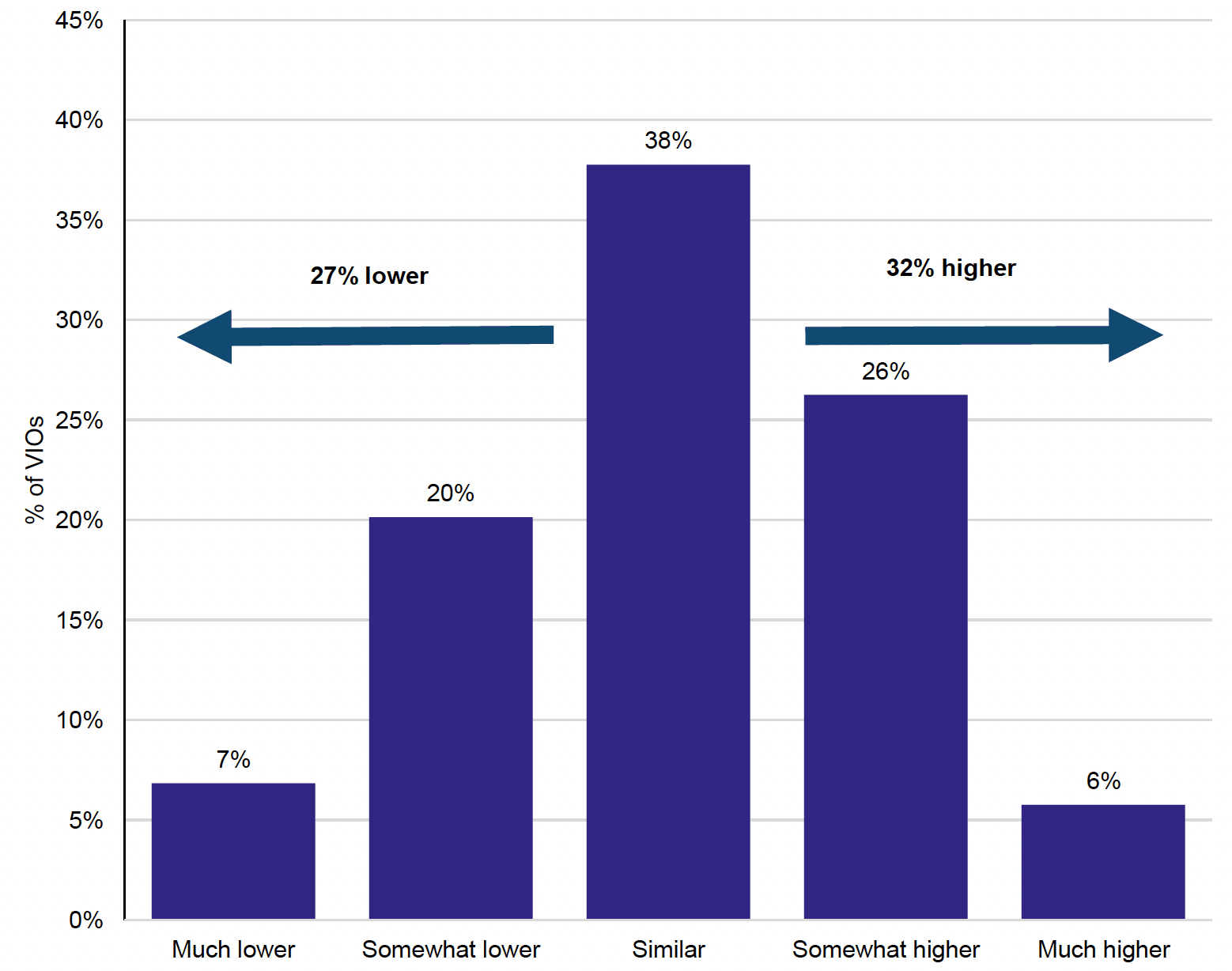
7.2 Meeting the needs of service users and communities
We asked VIO respondents about the extent to which they felt their organisations were able to meet current needs in the groups and communities that they work with. At the time of the survey (April-June 2021), 62% of VIO respondents said that they were able to meet most or all current requests for support, compared with 33% which said that support requests could not all be met, and in some cases far exceeded their capacity to respond (Figure 7.3).
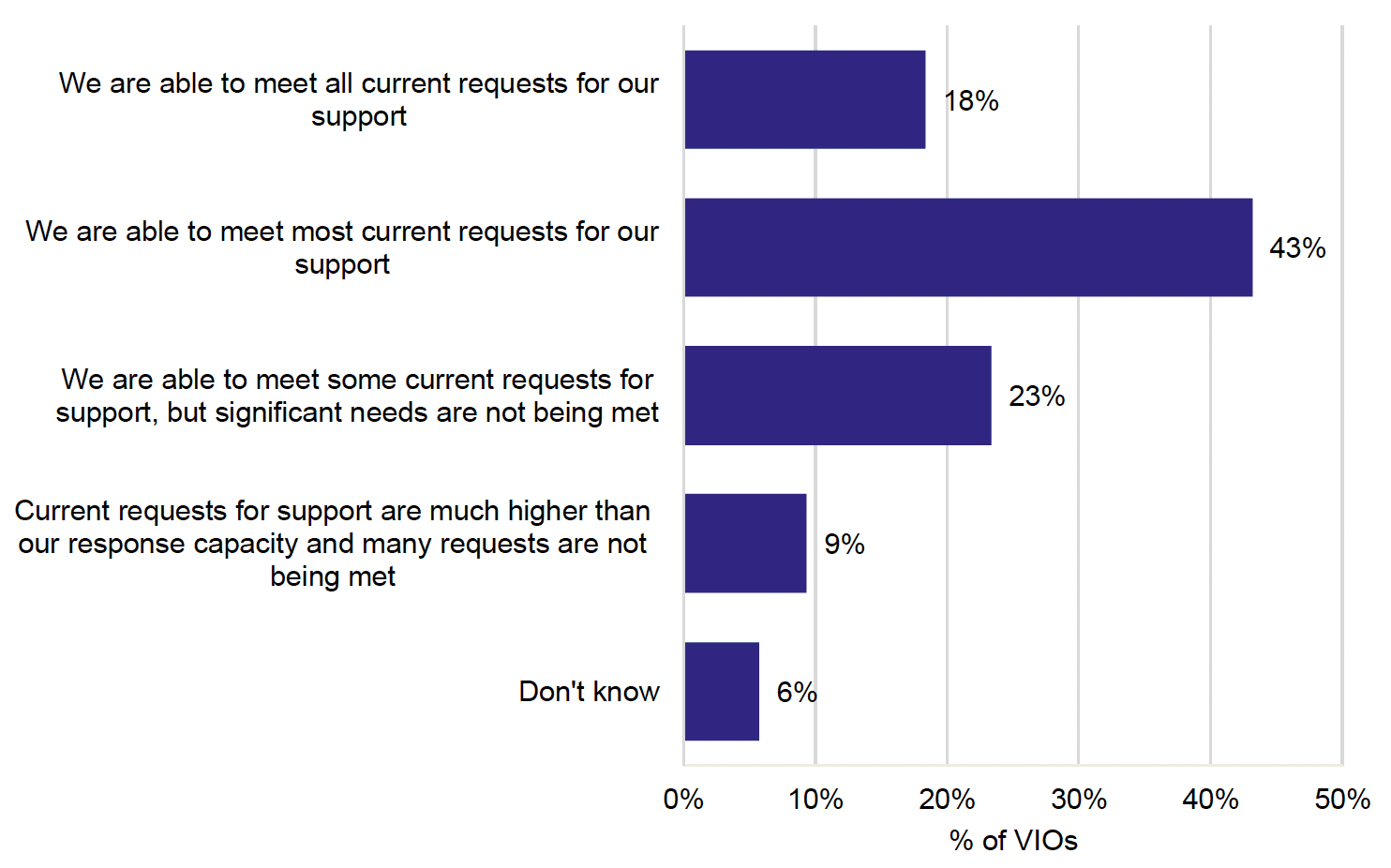
The views of infrastructure organisations were similar to those of the VIOs, with 25% of infrastructure organisations stating that the current response was meeting all support requests, and 54% saying that most support requests were being met. Infrastructure organisations were less likely than VIOs to consider that the response was unable to meet current levels of request. This may be a result of the fact that volunteer-involving organisations were responding in relation to the capacity of their own organisation to meet the needs of their specific target group(s); many of them delivered face-to-face services which had paused during the pandemic, and had not yet restarted at the point of the survey. Infrastructure organisations were taking into account the wider picture of response capacity across their areas, including informal volunteering and mutual aid/community response groups (Figure 7.4).
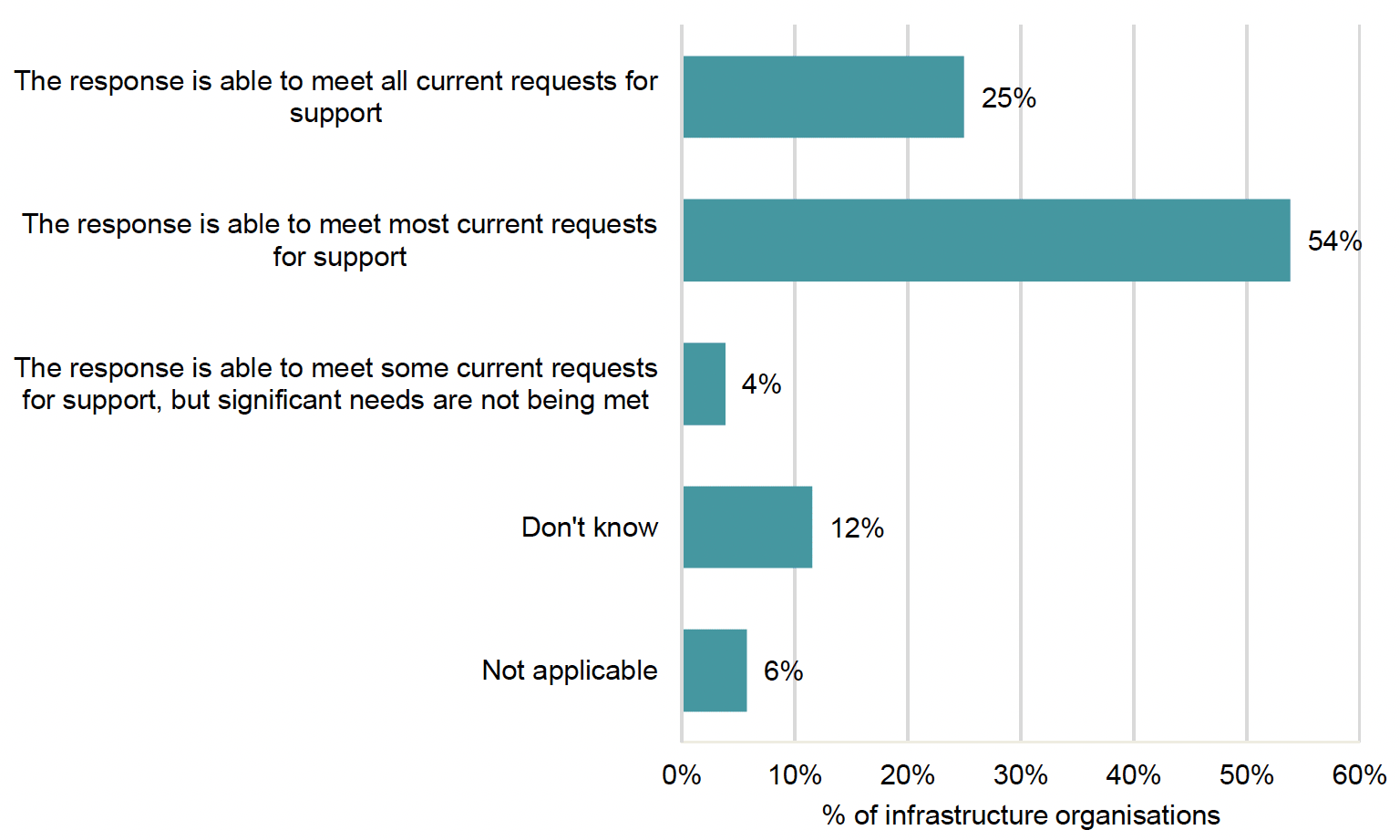
7.2.1 Lack of resources to meet the needs of service users
Capacity issues were the main problem that VIOs were experiencing in terms of being able to meet the needs of the groups and communities that they wished to serve, with the vast majority of those who responded to this question citing this as a problem. VIOs either did not have sufficient volunteer and staff resources to meet the current demands placed on their services, and/or were not yet able to properly restart their services and activities due to COVID-19 restrictions.
'Referrals to our services are increasing day by day. We are managing but going forward resource and capacity wise we will be unable to meet the level of demand for services. Referrals to our domestic abuse service, perinatal befriending service and others have seen sharp increases, we simply do not have the staff capacity or resources to take on more referrals which is heart breaking as there is huge need. …We haven't yet seen the impact of the pandemic as we are still living through it but this will continue to be an issue to manage demand for services going forward. As we emerge out of this, we hope that volunteers will still come forward to help, as they will be a crucial part of the COVID recovery. [W]e need to emphasise that the recovery from COVID needs volunteers more than ever.'
'Older and younger people want to volunteer however organisations are still too afraid to start connecting people of different ages. …It is proving extremely difficult even though we know we desperately need this work to increase.'
'Many 3rd sector community-based organisations were not being offered during lockdown restrictions or their services are now running at a reduced capacity…these have been huge loss for our patients as many of these services offered meaningful opportunities to engage in purposeful and enjoyable activities in the community, bolstering connections with others outwith the hospital environment and aiding recovery.'
7.2.2 Funding for dedicated volunteering support
A lack of funding to help address these capacity issues – for example by ensuring that there are dedicated staff in place to support volunteering – was raised by a number of VIOs:
'Due to funding we can't run enough programmes (particularly in Glasgow) to meet the emerging mental health crisis in young people.'
'We now need funding for a volunteer co-ordinator to meet the need of demand and support for some of our volunteers.'
'As we have failed to secure funds for a dedicated…officer, our responses to cases which are brought to our attention are of an ad hoc nature and woefully inadequate. Without competent capacity, we are not proactive and already stretched staff support only the most vulnerable particularly where children are involved. When urgent referrals are made and we fail to pick them up and offer support as needed, we disappoint people/families at a time when they desperately need our support and reassurance.'
7.2.3 Delivery of face-to-face services
Capacity issues have inevitably led to delays in service delivery, and growth in waiting lists for services. The delivery of face-to-face services has been particularly affected, since these are resource intensive to provide and also much more challenging to deliver in accordance with COVID-19 restrictions. VIOs also noted the growth in demand for mental health support such as counselling.
'Our waiting list for our most in demand service keeps rising but we have lost over half volunteers who deliver it. …Other services are still in demand even though we have had to pause them entirely and we continue to get enquiries about them. We are still not able to deliver face to face services even though those we support are asking for them.'
'Many of our services supporting clients F2F have had to cease during COVID and have to become virtual which provides some support but significantly less then needed. We are now starting to get back to delivering these services F2F but due to restriction in numbers still and backlog of people waiting it will take some time to get to our normal operating standards.'
7.2.4 Digital engagement doesn't meet everyone's needs
According to almost a fifth of those who responded, digital engagement has not been able to meet the needs of all services users and programmes.
'Due to the fatigue of using online connections experienced by our young people attending school, we have not been able to operate the youth club in the way we would like in order to protect young people's mental health and give recreational opportunities.'
'We usually set up physical information stalls within community centres to speak to women affected by domestic abuse. We have adapted and set up some virtual drop-ins but we are worried in case we are missing women who are unsafe at home to seek support.'
'Our communities have become a little more fractured than they were. 67% don't have the technology that fully enabled them to participate during lockdown and they have become incredibly stressed and distressed in some cases. Most have some phone/old computer many without camera etc. [The] vast majority of adult learners felt they were mostly forgotten about because there was limited resource set up early.'
'Most of our volunteers do not like using Zoom and will refuse to use it. …We do not have enough staff to support people remotely without volunteers, so remote support hasn't happened. …Due to most people not having their hearing aids maintained for over a year, a lot of people's aids are no longer working. …Most of these people are elderly so do not use email or Zoom so they go unsupported, and can't even keep in touch with friends and family via phone. Due to this increased social isolation, cognitive functioning has been in rapid decline (and risk of falls due to poor balance have been on the increase) so we're finding more of our user group in need for additional home help or in need for care home places. These people probably could have had more years living independently had we have been able to continue delivering our service. However, Audiology wouldn't allow it, we couldn't use NHS buildings, community buildings were closed, and we didn't have the staff resources or the financial resources to adapt quickly like other larger organisations have done.'
7.3 Emerging needs
We asked all of the survey respondents to tell us about the emerging needs that they were aware of in the communities with which they work, and to consider what they thought were likely to be the most important emerging needs over the next year. As shown in Figures 7.5 and 7.6 below, both VIOs and infrastructure organisations agreed that their primary areas of concern were around mental health and wellbeing (as indicated by 84% of VIOs and 90% of infrastructure organisations) and loneliness and social isolation (73% and 88%).
Financial hardship and concerns about unemployment/redundancy were the next most highly cited areas of emerging needs (54% and 69%), alongside digital inclusion and access (52% and 77%).
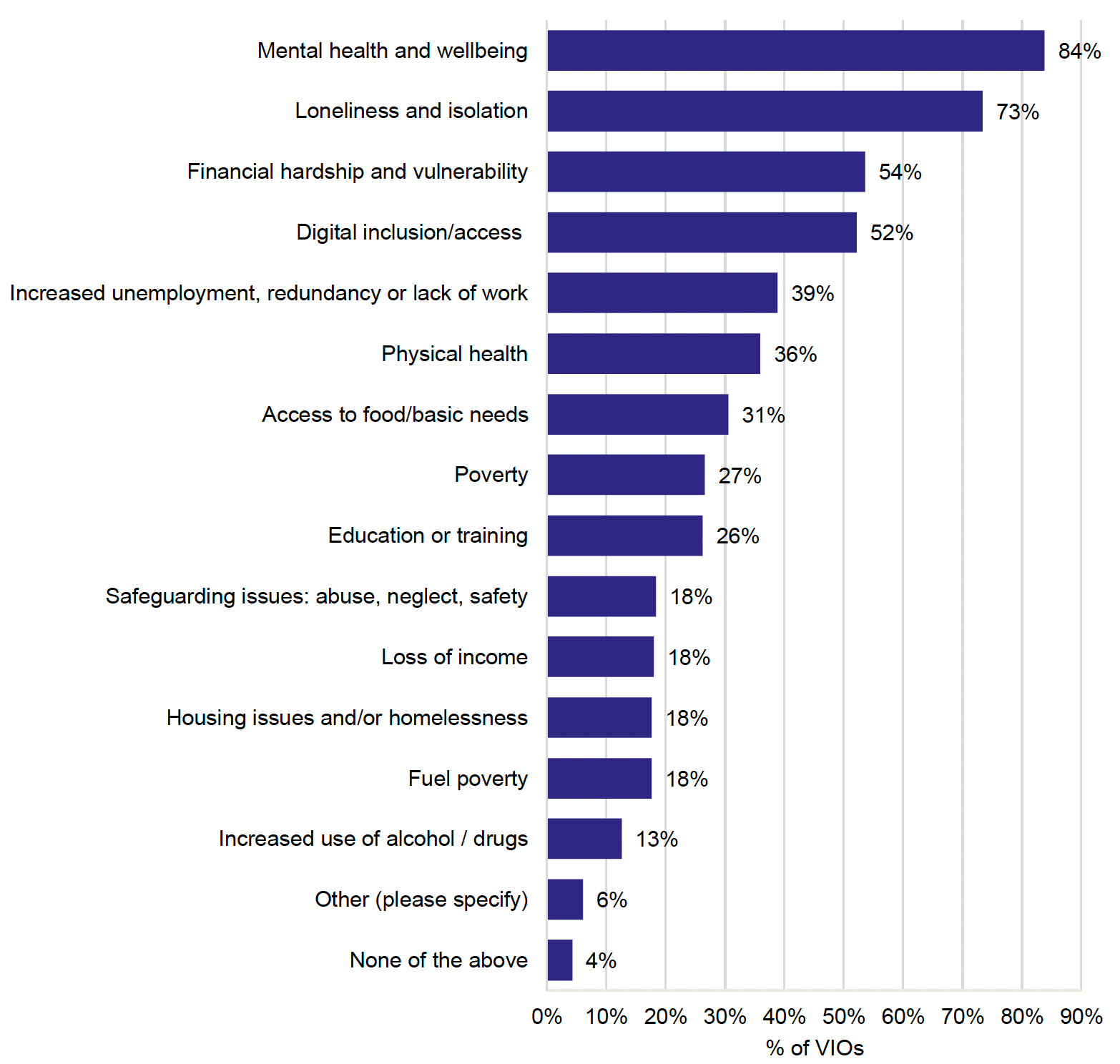
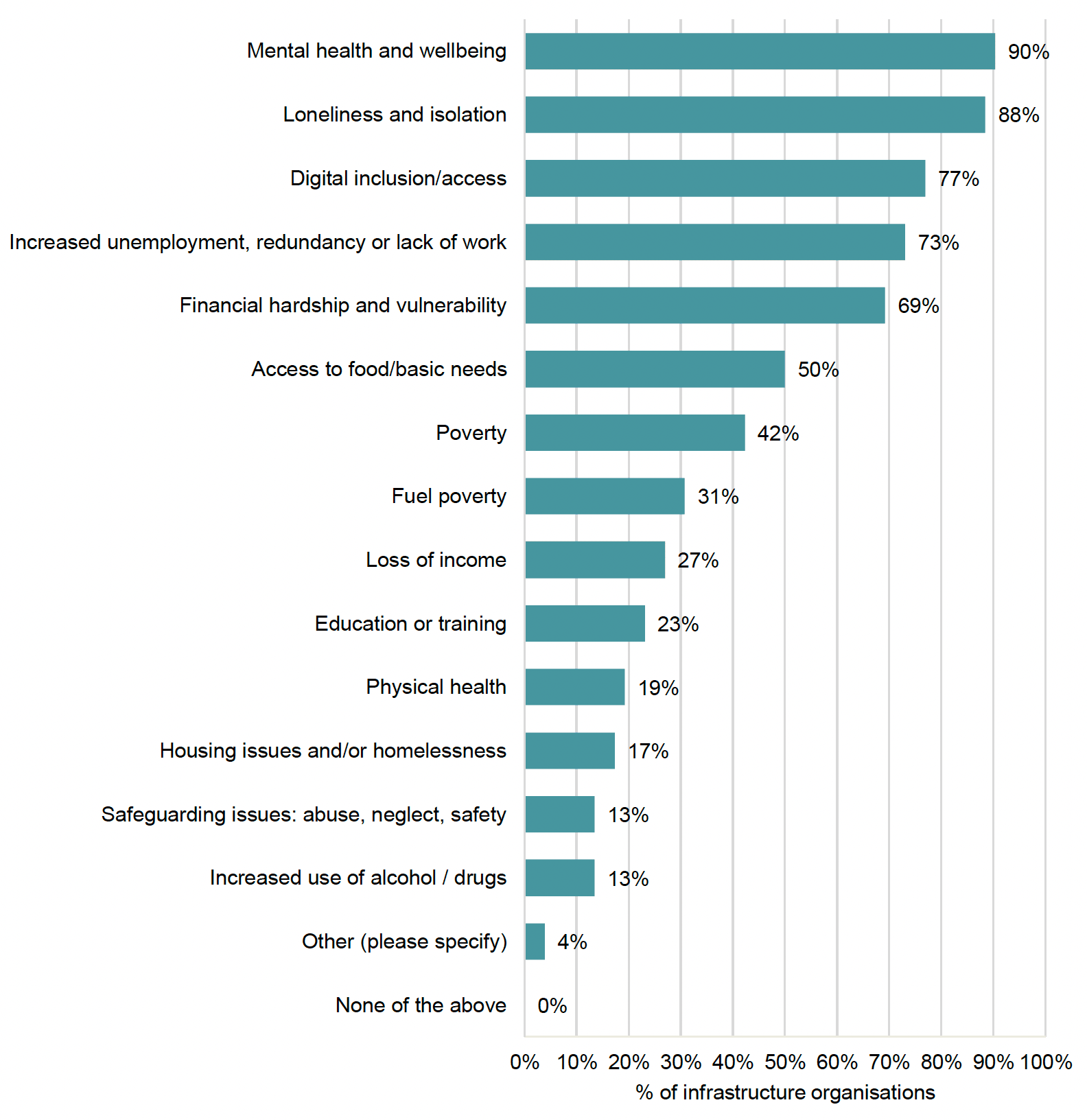
Many survey respondents were clearly very concerned about the long-term impacts of the pandemic on mental health and wellbeing, and on social isolation and loneliness, particularly for older and more vulnerable people who have spent much of the past 18 months in relative isolation. As one volunteer-involving organisation working with older people explained:
'Since COVID-19 measures came into place during 2020, older people's issues of loneliness, depression and inactivity increased. Through conversations with existing members, [we] found that people have been worried about being inactive but fearful of knowing what they can do due to COVID-19 rules and typically with both participants and carers feeling increasingly isolated and anxious. Many of the demographic have been though long periods of shielding due to age and health conditions and remained at home for months without seeing other people. Many of the participants are increasingly feeling lonelier and want someone to talk to and engage with them with their interests to take their mind off the outside world.'
VIOs expressed concern that funding and services will not be sufficient to meet these emerging needs.
'Due to funding we can't run enough programmes (particularly in Glasgow) to meet the emerging mental health crisis in young people.'
'We are finding that the previous challenges of health and finances are exacerbated by the pandemic.'
'Isolation and social contact are a problem for our service users so volunteers can provide befriending to help alleviate this. However, staff time to recruit train and support volunteers is lacking.'
'Need for more activities being delivered to reduce isolation, tackle mental health, loss of confidence. Need to help people transition out of lockdown and support them to get back out safely and confidently.'
'We work with many people who are older and have health conditions who have been most affected by the lockdown. We are expecting high levels of demand for our services as these people come out of the lockdown.'
7.4 VIO priorities for engaging and supporting volunteers during the pandemic recovery
The main priorities expressed by VIOs for volunteering during the next phase of the pandemic and recovery were focused on responding to changing COVID-restrictions; restarting volunteering and encouraging pre-existing volunteers who have stopped to return; and ensuring volunteer health and wellbeing (Figure 7.7).
Engaging new volunteers, and training volunteers to do new types of volunteering such as volunteering remotely were the areas of next highest priority, but overall greater priority was given to getting pre-existing volunteers back into volunteering, over engaging new volunteers.
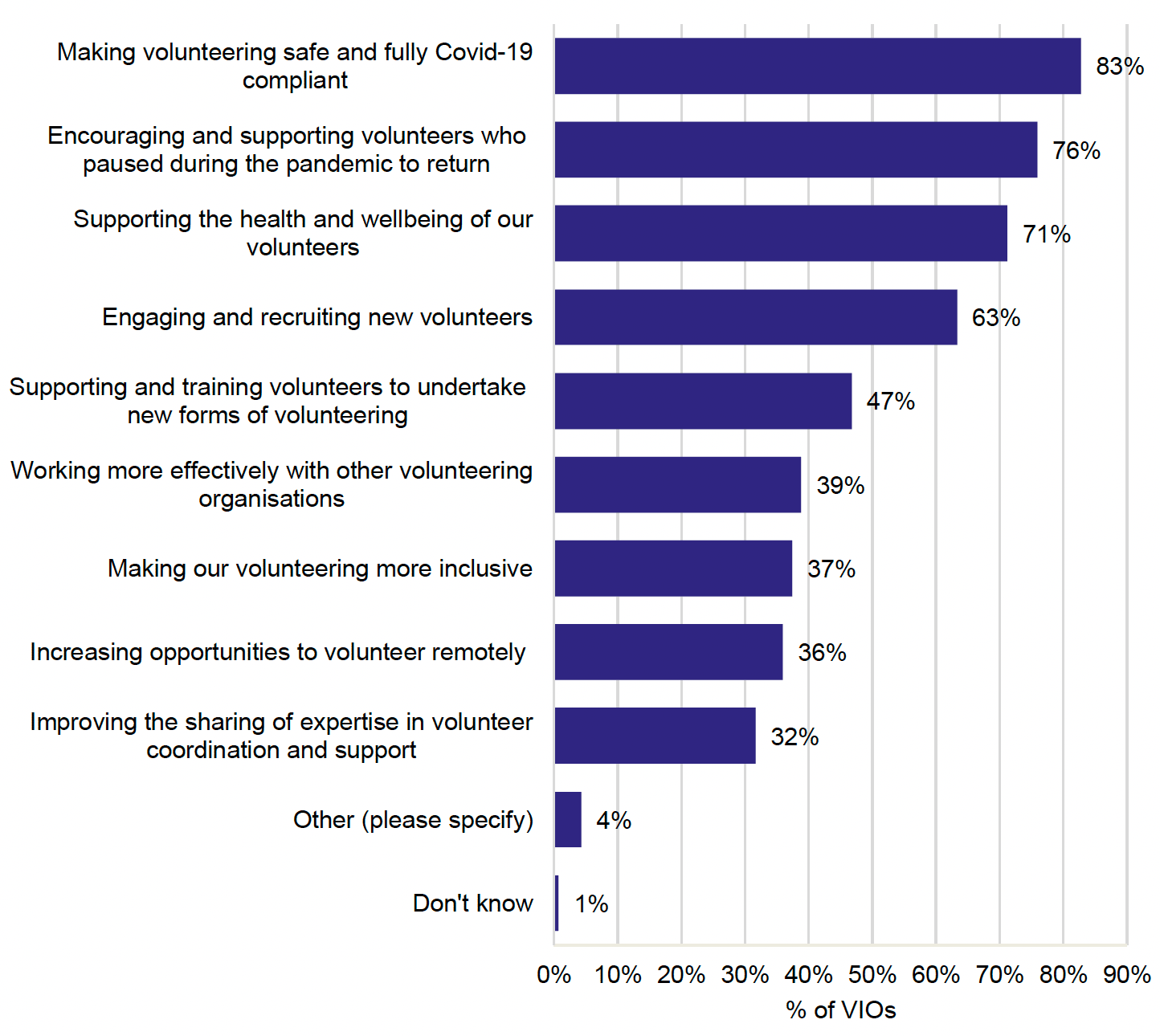
Some 37% of VIOs said that making their volunteering more inclusive was a priority. The groups that they listed as wanting to reach more effectively included: young people; people with disabilities and health conditions – who organisations identified as having been at higher risk of exclusion from volunteering opportunities during the pandemic; people from BAME communities; and volunteers from deprived or socio-economically disadvantaged areas and backgrounds.
'Within [our] volunteering strategy there are initiatives aimed at increasing diversity and inclusion in our volunteering programme. We are aiming to recruit volunteers from a broader range of socio-economic backgrounds. We're also aiming to work with more volunteers under 25 to make sure our volunteering programme is engaging for this age group. We also want to make sure that [our] volunteers reflect the ethnic make-up of Scotland and reflect the families who use our services. Part of this will involve recruiting volunteers who speak languages used by our service users.'
'We want to reach out to more disadvantaged communities to engage them in volunteering. This will include in-person outreach as well as making our training and volunteering opportunities more inclusive. We also want to start offering paid placements to make us accessible to those who can't afford to volunteer with us but would still benefit from the skills and experience they would gain.'
Some respondents also noted that there may be a need to target groups who have been particularly affected by the pandemic, and who could benefit from the opportunities that volunteering can generate.
'Recruiting across all demographics but specifically targeting 16 to 24 year olds who are unemployed and looking to develop their skills, build their CV and grow in confidence along with the 55+ audience also looking to grow confidence, possibly pivoting their career as a result of redundancy and those feeling socially isolated.'
7.5 The support that VIOs need to deliver volunteering programmes during the COVID recovery
We asked VIOs what support, if any, they need in order to support volunteering within their organisation during the long-term recovery phase over the next two years. We also asked them to tell us what other organisations, such as national or local government, intermediary organisations and others can do to support the recovery in volunteering.
7.5.1 Dedicated funding for volunteer coordination and support
Overwhelmingly, VIOs said they needed sustainable and longer term funding for core costs in general, and in particular funding for dedicated posts to support volunteer coordination and management. A large number of VIOs would like to hire volunteer managers and staff to support volunteers. They highlighted how a lack of funding for volunteer coordination roles in particular is limiting their ability to restart volunteering after the pandemic, as well as a lack of recognition that running volunteer programmes comes with costs attached. Additional funding would also allow some VIOs to expand their services and the associated volunteering opportunities. Some VIOs have been unable to undertake their usual fundraising activities during COVID-19 and require shorter term funding until fundraising operations are fully back in place.
'Like many voluntary groups we need to not rely on volunteer co-ordination, we need core support for admin function, organising, project management, volunteer management, accountancy, governance and all the other functions that a voluntary organisation supporting 200 volunteers and providing community services needs to function, this means support for paid hours not endless offers of training, which further eats into available volunteer time, or support from outside agencies who do not engage with or understand the local community.'
'The biggest support that we need is funding in order to continue the role … of volunteer coordinator. This is a vital role. …If we cannot sustain this post, there will be a significant capacity problem to recruit, support, training volunteers.'
'Recognise that volunteers are not free. Funding is required for resources such as volunteer expenses, equipment, training. Staff time for training and for them to provide supervision and support to volunteers.'
'We need continuation funding for the vital role of Volunteer Co-ordinator. A single person working part-time can support a whole lot of volunteering activity and can encourage people who are new to volunteering and can support those experiencing disadvantages to still volunteer within their community. It is a really essential role and without a Volunteer Co-ordinator we will lose many of our volunteers and our volunteering opportunities.
It is therefore vital there are funds available for the direct support for volunteering as it is all about building relationships with people and giving them individual support. So many of the volunteers we have worked with over the last few years have gone on to get employment, improved mental wellbeing and felt less isolated. We are a community and this is down to having a dedicated staff member to support volunteers.'
'Supporting and training volunteers is very expensive and support would be welcome.
7.5.2 Support for the costs of dual delivery and hybrid working
Some VIOs noted that they will need to provide both face-to-face and online/digital services simultaneously over a number of months, and that this dual delivery has additional resource requirements and costs.
'[We need] transition funding to cover the move back from remote to face-to-face delivery: we will be operating both forms of delivery for the next 6 months which will require increased staff time.'
Digital volunteering and service delivery was the second most-commonly mentioned area where VIOs said they needed support, recognising that there may be demand for longer-term remote volunteering or service delivery.
'Digital support to upskill volunteers will be necessary especially if more remote volunteering is to take place. We have introduced a new volunteer role to support our community teams who are delivering sessions through zoom to reach clients in more remote and rural areas. We have set up support sessions for the volunteers on how to use zoom so that they feel more confident in taking part. Nationally a more stable internet service will be needed to enable this work to continue especially in rural areas.'
'Digital skills training to be offered to volunteers who don't feel confident - for training to be more accessible and widely advertised if it exists.'
7.5.3 Support for volunteer training and accreditation
Supporting volunteer and staff access to free or low-cost training was a priority for several VIOs. Training needs were diverse, depending on the specific focus of the organisations. The recognition and accreditation of volunteering was mentioned by a few respondents as an area that needs more development.
'Free volunteer training programmes which are certificated. Our TSI previously provided training, however, what we need is to have more flexible training online.'
Training and information on how to adapt to the changing COVID context and restrictions were also frequently mentioned, with a need for clear guidance on managing volunteering within the changing restrictions.
7.5.4 Recognising and celebrating the value of volunteering
Finally, another area of priority for VIOs is the recognition and celebration of volunteering. Organisations view this as essential for promoting the value and benefits of volunteering in order to engage more people; and a way to ensure that volunteers themselves are recognised and accredited for the skills, experience and training that they develop in their roles as volunteers. In the context of the recovery from the pandemic, organisations feel it is important to recognise the role and contribution of volunteers in rebuilding within communities and services, as well as the support that volunteering can provide for people who need to develop new skills or confidence in order to gain or regain paid work.
'We have worked recently to coordinate volunteering across organisations and would like to explore a volunteer passport to enable different organisations to recognise training and accreditation and enable volunteers to move and support surge.'
'Continued and ongoing recognition of volunteering within our own organisation, measuring the value of volunteering and of volunteer managers. From this, developing additional resource within our own organisation. More and improved ways of recognition for volunteering and volunteer management within the sector, raising the profile of volunteering and volunteer management. Campaigns, and positive and effective media promotion/attention. Government commitment and higher level support.'
'The Scottish Government should also consider a campaign to incentivise private and public sector companies to formally recognise volunteering and support employees to undertake voluntary work.'
'Continued and ongoing recognition of volunteering within our own organisation, measuring the value of volunteering and of volunteer managers. From this, developing additional resource within our own organisation. More and improved ways of recognition for volunteering and volunteer management within the sector, raising the profile of volunteering and volunteer management. Campaigns, and positive and effective media promotion/attention. Government commitment and higher level support.'
From an organisational perspective volunteers need to be supported, encouraged and developed. If they are helping the community then they deserve to get something back for those efforts by receiving training, support and encouragement to have a voice in the community. Capacity within organisations while supported by volunteers to help with projects is also on the other hand stretched by managing volunteers. Especially if we are to manage and support volunteers well and help them develop and feel included. We need funding support for volunteer co-ordinators to support and retain volunteers.'
'Most obviously, we need greater rewards for volunteers. The Saltire Awards are great for younger people but there are no rewards system or similar for those over the age of 25 years. Volunteers need to be supported and encouraged more. Many of our volunteers have been out of or have never been part of the job market and find accessing employment very difficult and volunteering experience is not fully recognised by employers. There needs to be a national recognition scheme for volunteers particularly those who have lived experience of poverty, addiction, exclusion who are helping through their experience to help others and using their voices to design and deliver services to receive greater recognition.
7.6 How infrastructure organisations plan to support recovery in volunteering
We also asked infrastructure organisations about their views on the priority measures for supporting the recovery of volunteering in their area during the next 12 months (ie from mid-2021 to mid-2022). Ninety percent of infrastructure organisations said that funding support for volunteering programmes and priorities was either very important or important to support recovery in volunteering, echoing the views of VIOs themselves who cited funding as the biggest priority. Support for volunteer coordination within local areas was a high priority, with 80% saying this was very important or important. Developing and embedding different models for supporting volunteering – such as digital and remote forms of volunteering – were considered to be very important or important by 83% of infrastructure organisations, acknowledging the potentially important role that diverse forms of volunteering may play over the longer term.
Infrastructure organisations also highlighted the need to respond to inequalities in volunteering, and the need to tackle the exclusion of groups that are currently unable to volunteer as significant priorities. These emerged as higher current priorities for infrastructure organisations than for VIOs – 81% of infrastructure organisations said that tackling exclusion was a priority, compared with 37% of VIOs that said they were currently prioritising making volunteering more inclusive. For VIOs, at the time of the survey (just following the second lockdown) the primary focus was on the significant challenges of getting core programmes running again, reaching service users, restarting volunteering safely, and finding ways to re-engage volunteers who had stopped due to the pandemic.
Infrastructure organisations recognised the role that informal volunteering and mutual aid have provided during the pandemic. As shown in Figure 7.8 below, 81% of respondents said it was important or very important to recognise and support informal volunteering going forward, and 67% felt that it was important or very important to support mutual aid groups where they want to continue to support communities. Respondents recognised that there may be continued opportunities to harness the upswell in willingness to volunteer during the pandemic and turn this into longer-term engagement.
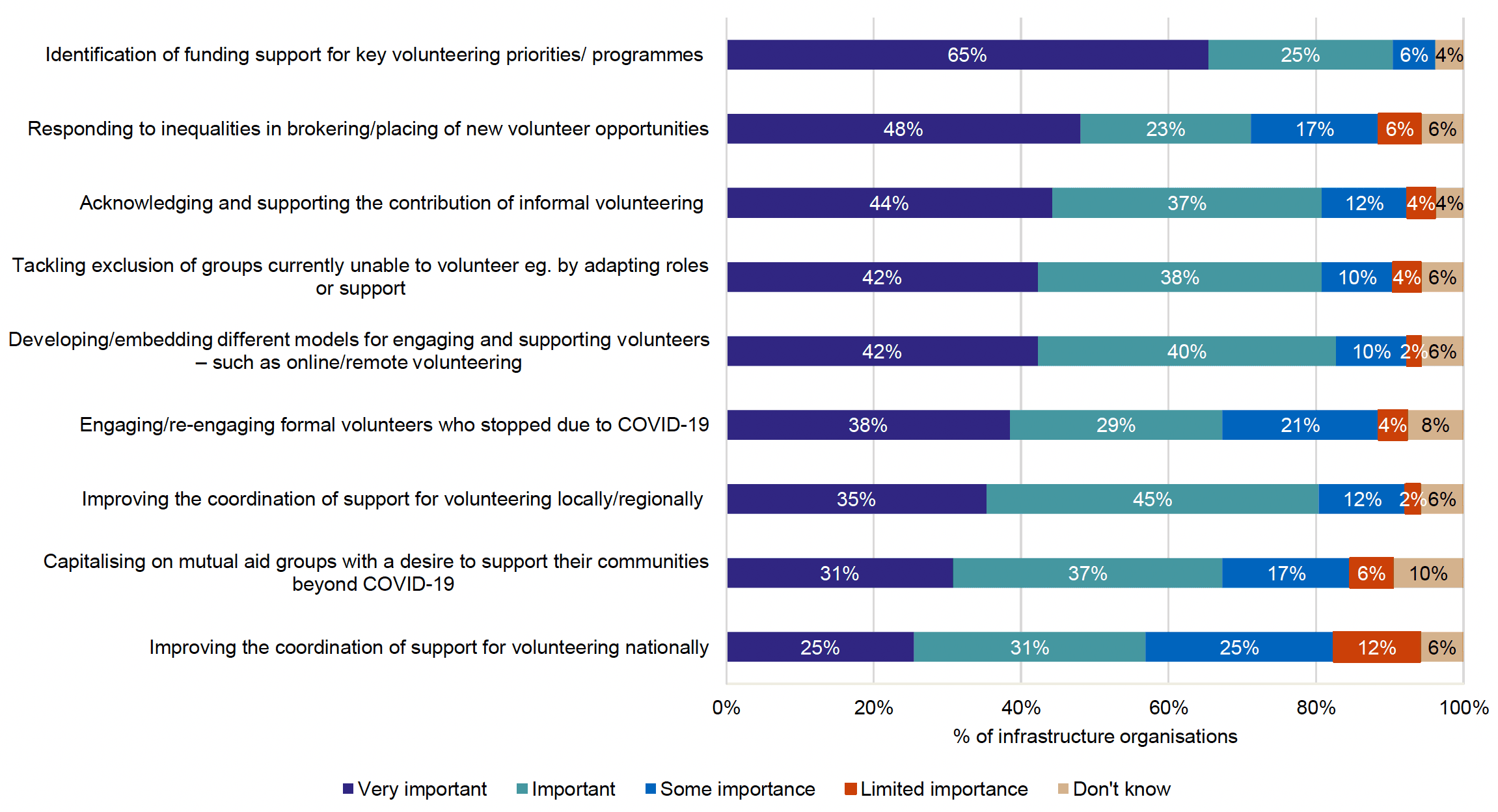
Infrastructure organisations were asked to tell us what their own organisations were doing or planning to do to support the recovery in volunteering. Key themes that emerged included support for volunteering and volunteers; training; partnership working; online services; and recognition.
7.6.1 Area-based promotion of volunteering and volunteering opportunities
Infrastructure organisations recognised the need to support volunteer-involving organisations to enable pre-existing volunteers to return to volunteering, to create more inclusive opportunities for new volunteers, and to support the gains that have been made during the pandemic in attracting new volunteers and developing new ways to volunteer. Whilst acknowledging that much of this work will need to be led by VIOs themselves, infrastructure organisations see opportunities to support this, through their area-based promotion of volunteering and volunteering opportunities; work to promote volunteering with employers and other partners; and streamlining and support for pathways into volunteering.
'We are utilising our new developments on our Salesforce EPI system to broadcast new volunteering opportunities to the bank of volunteers who signed up during COVID-19 as well as any newly registered potential volunteers to keep them engaged and to promote a continued interest in volunteering. We have developed a Community Response protocol based on COVID-19 pandemic to ensure we are ready and able to manage volunteer supply and demand quickly and efficiently.'
We are supporting organisations to work with their volunteers to try and retain them through increased flexibility of roles moving forward, recognising and supporting volunteer wellbeing is also really important. Being part of other volunteering networks we are keen to drive forward the Volunteering Action Plan and opportunities such as employer supported volunteering to help retain those who were able to volunteer whilst on furlough. Cost of inclusive volunteering also needs recognised as do the many benefits of volunteering.'
'We are working with our minority communities to ensure volunteering is inclusive and that organisations have taken an active approach to inclusive practices. We are reviewing our own practices for volunteer signposting and recruitment to ensure they are not inadvertently setting barriers for individuals to volunteer.
'We continue to work closely with the [area-based] Volunteer Managers Forum to explore volunteer role development, volunteer support, and volunteer recognition. The forum meets every two months and communications are shared with this forum as and when on training opportunities, volunteer funding, updated best practice etc.'
'We are working with employability partners in [local authority area] to ensure volunteering remains an option for individuals who want to build their experience and skills as part of their volunteering journey.'
'We have newly recommitted to delivering the updated Volunteer Friendly Award in [local authority area], and were part of the steering group for its review. We will be promoting this to volunteer groups across the area to encourage best practice with regards to recruitment, inclusion, support, safeguarding and recognition.'
'We have reconnected with local schools to encourage uptake of the Saltire Awards and to encourage recognition of digital volunteering that was done by young people over the course of the pandemic.'
'Working in partnership with the TSI to maintain the good practice demonstrated and learnt during the pandemic. Investing additional support in the TSI to lead the recovery response in certain areas – including sustainable food provision. Investing in a new volunteer management portal. Continuing to celebrate and encourage volunteers through [local campaign].'
7.6.2 Supporting volunteer wellbeing and resilience
There was recognition that more support for volunteer wellbeing and resilience is needed, in particular for volunteers who are not connected to formal support or supervision. Support can help to ensure the continued engagement of people who want to volunteer over the longer term.
'Support for volunteers is needed and wellbeing sessions will be important for the volunteers who do not receive any formal support of supervision. We need to make that pathway of support clear and TSIs have an important role to play in helping forge a path. …In most volunteering research, we can see that when asked, most people will say they will continue volunteering or would consider volunteering in the future. However, in order to make this future thought into a reality – volunteers and volunteer co-ordinators need support and this needs to extend to informal groups. TSIs need to be resourced to continue with this growth.'
7.6.3 Providing training and other services for VIOs and volunteers
Providing training to VIOs on issues related to volunteering, and in some cases providing direct support or training to volunteers, was another area of priority. Developing and maintaining online services was also an area where infrastructure organisations intended to provide support.
'Our volunteer management forum for example have gone back to basics with groups in training for recruiting, managing and retaining volunteers - reflecting the changes in practice due to COVID and moving forward.
We are also working on setting up a "Volunteer Passport Scheme" locally to streamline the route to volunteering both for volunteers and VIO's.'
'We are looking at buddy volunteering for those who have low self-esteem and although they may wish to volunteer they will require support. We would hope to provide a volunteer coordinator who would support a small group of buddy volunteers who would attend volunteering opportunities with volunteers who require support to start their volunteering journey. We are also working with statutory partners and volunteer involving organisations to support young people into volunteering and beyond'
'We have already redeveloped our capacity building services for VIOs including our good practice wiki www.volunteerwiki.org.uk and have reworked our training to be delivered in a blended way. This is proving very popular.'
7.6.4 Building on partnerships forged during the pandemic
Infrastructure organisations recognised that they had made real improvements in partnership working during the pandemic, and wanted to take steps to maintain or build on this.
'We are working closely with local strategic partners to ensure that volunteering is included in local agendas/policies and attending strategic groups to raise the profile and need to support volunteering. Plan to develop new volunteering strategy for the area in the next year, with partners closely involved to ensure shared ownership of volunteering across a range of local agendas/groups. Ongoing dialogue with VIOs to check needs and support required.'
7.6.5 Recognising and celebrating the value of volunteering
As for VIOs, infrastructure organisations also felt that recognition of volunteering is a priority, and that this needs to be integrated into plans for the recovery period.
'Continue to recognise the great efforts of volunteering in our Isles and work with communities to continue to see volunteering as an important way of island life. Continue to support organisations to adapt to the changing times as we move back to 'normality'. continue with representation on multi agency groups to ensure an effective model of volunteering is embedded in our isles.'
7.7 Priorities for other stakeholders in supporting recovery in volunteering
Infrastructure organisations were also asked about what the priorities should be for other local and national stakeholders in supporting recovery in volunteering.
Infrastructure organisations felt strongly that funding should be a priority for other stakeholders. There were calls both for short-term funding to support recovery and adaptation into the recovery phase, and also for longer term sustainable funding to support the work of VIOs delivering volunteering programmes, and to ensure continuation and improvement in the work that TSIs and other volunteer-coordination organisations do to promote, support and coordinate volunteering locally.
'Additional funds are needed to support organisations to increase their capacity to support volunteering. Social distancing measures and anxieties on return to volunteering will have a negative effect on volunteering, particularly on people with additional support needs.'
'Greater understanding and recognition of (a) TSIs' expertise, opportunities to develop and capacity to offer increased support for volunteering locally and (b) the limitations of current funding (and match funding) for TSI Volunteering Services in the context of so many competing demands on TSIs.'.
One respondent felt there was an opportunity to retain and build on the speed and simplicity of funding processes that were in place during the pandemic.
'I would like to see us use our learning and experience from the pandemic as we move into the recovery phase. Some of this learning is how National and Local Funders were able to put processes in place to distribute funds to those in need in a quick and simple process. Some Funders can take the best part of six months to confirm funding which can be detrimental to an organisation so if we can speed this process up but still ensuring the same level of information and delivery, I think this could be a huge positive.'
The second area that infrastructure organisations highlighted as a priority for other stakeholders was ongoing commitment to collaboration and partnership working, building on what has been achieved in this respect during the pandemic.
'A more co-ordinated approach to how we develop and support volunteering would be helpful. Regular discussions with Volunteer Scotland about how local areas are developing volunteering and what gaps in opportunities, or volunteer recruitment we have and how we can work together to address gaps.'
'This work has already begun.... Re-vitalization of the Volunteering for All approach, that recognizes the contribution of informal volunteering and participation in local activities would help encourage those not yet ready/interested in formal volunteering to continue to participate.'
Contact
Email: socialresearch@gov.scot
There is a problem
Thanks for your feedback